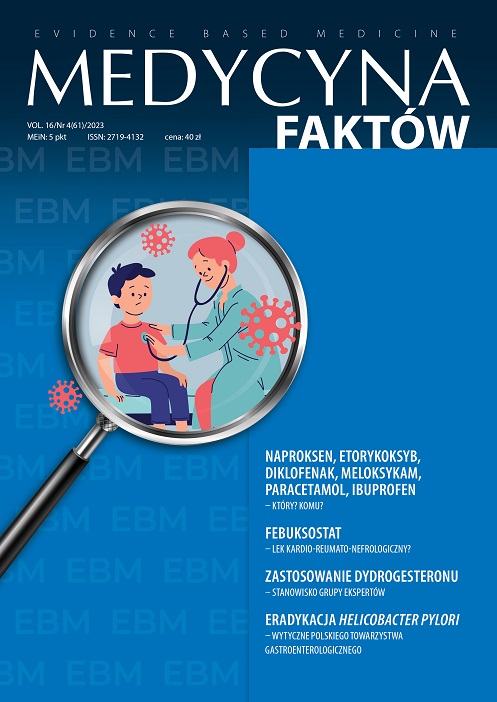Benefits of using inosine pranobex Review article
Main Article Content
Abstract
An increased interest in the therapeutic potential of inosine pranobex (IP) is a consequence of demand for new antiviral drugs, created by the COVID-19 pandemic. It has been proved that IP inhibits replication of many viruses and has an immunomodulatory effect on the host organism. IP influences humoral and cellular aspects of immune response. Of significant importance in general practice/family doctor practice is the IP potential in the prevention and treatment of viral acute upper airway infections, where the etiological orientation of therapeutic procedure is recommended. Clinical studies point also to clinical advantages from the use of IP in treating infections caused by Herpes simplex viruses, including the IP-induced decrease in the frequency of infection recurrence. Current findings concerning a possible IP impact on the course of COVID-19 infection are not conclusive and require further clinical studies. It should be emphasized that the valuable effect of the use of IP in treating viral infections may consist in the early immunomodulatory intervention that corrects immunosuppression and lymphopenia related to viral infection, which may affect its course.
Article Details
Copyright © by Medical Education. All rights reserved.
References
2. Thorsen S, Pedersen C, Sandström E et al. Kontrolleret, klinisk afprøvning af isoprinosin til HIV-smittede. Resultater af en dansk/svensk multicenterundersøgelse. The Scandinavian Isoprinosine Study Group [Controlled, clinical trial of isoprinosine administration to HIV-infected patients. Results of a Danish/Swedish multicenter study. The Scandinavian Isoprinosine Study Group]. Ugeskr Laeger. 1994; 156(22): 3314-8.
3. Pedersen C, Sandström E, Petersen CS et al. The efficacy of inosine pranobex in preventing the acquired immunodeficiency syndrome in patients with human immunodeficiency virus infection. The Scandinavian Isoprinosine Study Group. N Engl J Med. 1990; 322(25): 1757-63.
4. Mohanty KC, Scott CS. Immunotherapy of genital warts with inosine pranobex (Imunovir): preliminary study. Genitourin Med. 1986; 62(5): 352-5.
5. Charakterystyka produktu leczniczego Groprinosin Forte, 1000 mg, tabletki.
6. Lasek W, Janyst M, Młynarczyk G. Inhibition of adenovirus multiplication by inosine pranobex and interferon α in vitro. Cent Eur J Immunol. 2015; 40(4): 395-9.
7. Beran J, Špajdel M, Slíva J. Inosine Pranobex Deserves Attention as a Potential Immunomodulator to Achieve Early Alteration of the COVID-19 Disease Course. Viruses. 2021; 13(11): 2246.
8. McCarthy MT, Lin D, Soga T et al. Inosine pranobex enhances human NK cell cytotoxicity by inducing metabolic activation and NKG2D ligand expression. Eur J Immunol. 2020; 50(1): 130-7.
9. Waldman RH, Ganguly R. Therapeutic efficacy of inosiplex (Isoprinosine) in rhinovirus infection. Ann N Y Acad Sci. 1977; 4(284): 153-60.
10. Khakoo RA, Watson GW, Waldman RH et al. Effect of inosiplex (Isoprinosine) on induced human influenza A infection. J Antimicrob Chemother. 1981; 7(4): 389-97.
11. Beran J, Šalapová E, Špajdel M. Isoprinosine Study (EWO ISO-2014/1) Team. Inosine pranobex is safe and effective for the treatment of subjects with confirmed acute respiratory viral infections: analysis and subgroup analysis from a Phase 4, randomised, placebo-controlled, double-blind study. BMC Infect Dis. 2016; 16(1): 648.
12. Gołębiowska-Wawrzyniak M, Markiewicz K, Kozar A et al. Immunologiczne i kliniczne badania nad przydatnością terapeutyczną inozyny pranobeks [Immunological and clinical study on therapeutic efficacy of inosine pranobex]. Pol Merkur Lekarski. 2005; 19(111): 379-82.
13. Majewska A, Lasek W, Przybylski M et al. Interferon-α and inosine pranobex-mediated inhibition of reploication of human RNA viruses in vitro. Med Dosw Mikrobiol. 2016; 68(1): 64-71.
14. Al-Sherees HAA, Al-Khateeb SNA, Al-Muhannak FHN. Immunological Activities of Isoprinosine Inhibition on Viral Infections in Human. Biosci Biotech Res Asia. 2019; 16(4): 773-8.
15. Ohnishi H, Kosuzume H, Inaba H et al. Mechanism of host defense suppression induced by viral infection: mode of action of inosiplex as an antiviral agent. Infect Immun. 1982; 38(1): 243-50.
16. Pachuta DM, Togo Y, Hornick RB et al. Evaluation of isoprinosine in experimental human rhinovirus infection. Antimicrob Agents Chemother. 1974; 5(4): 403-8.
17. Jayanthi CR, Swain AK, Ganga RT et al. Efficacy and Safety of Inosine Pranobex in COVID-19 Patients: A Multicenter Phase 3 Randomized Doubl-Blind, Placebo-Controlled Trial. Adv Ther (Weinh). 2022; 16: 2200159.
18. Beran J, Špajdel M, Katzerová V et al. Inosine Pranobex Significantly Decreased the Case-Fatality Rate among PCR Positive Elderly with SARS-CoV-2 at Three Nursing Homes in the Czech Republic. Pathogens. 2020; 9(12): 1055. Erratum in: Pathogens. 2021; 10(9): 1121.
19. Borges M, Borges M, Borges J et al. Experimental study: management of metisoprinol in patients with Covid-19. Universidad Ciencia Y Tecnología. 2020; 24(103): 41-50.
20. You Y, Wang L, Li Y et al. Multicenter randomized study of inosine pranobex versus acyclovir in the treatment of recurrent herpes labialis and recurrent herpes genitalis in Chinese patients. J Dermatol. 2015; 42(6): 596-601.
21. Tobólska S, Terpiłowska S, Jaroszewski J et al. Genotoxicity and Mutagenicity of Inosine Pranobex. J Vet Res. 2018; 62(2): 207-13.

